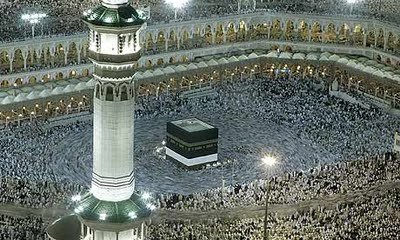
By Ben Child
10/3/2009
Islam's holiest site … Muslims circle the Kaaba inside the Grand Mosque in Mecca during the hajj pilgrimage. Photograph: Ali Jarekji/Reuters
He blew up the Empire State Building and the White House in Independence Day, sent a giant monster careering through the heart of Manhattan in Godzilla and destroyed the famous Hollywood sign in The Day After Tomorrow. But it seems there are places even Roland Emmerich will not go - the German film-maker has revealed he abandoned plans to obliterate Islam's holiest site on the big screen for fear of attracting a fatwa.
Islam's holiest site … Muslims circle the Kaaba inside the Grand Mosque in Mecca during the hajj pilgrimage. Photograph: Ali Jarekji/Reuters
He blew up the Empire State Building and the White House in Independence Day, sent a giant monster careering through the heart of Manhattan in Godzilla and destroyed the famous Hollywood sign in The Day After Tomorrow. But it seems there are places even Roland Emmerich will not go - the German film-maker has revealed he abandoned plans to obliterate Islam's holiest site on the big screen for fear of attracting a fatwa.
For his latest disaster movie, 2012, the 53-year-old director had wanted to demolish the Kaaba, the iconic cube-shaped structure in the Grand Mosque in Mecca that Muslims the world over turn towards every day when they pray and which they circle seven times during the hajj pilgrimage.
But after some consideration, he decided it might not be such a smart idea, after all.
"I wanted to do that, I have to admit," Emmerich told scifiwire.com. "But my co-writer Harald [Kloser] said I will not have a fatwa on my head because of a movie. And he was right.
"We have to all, in the western world, think about this. You can actually let Christian symbols fall apart, but if you would do this with [an] Arab symbol, you would have ... a fatwa, and that sounds a little bit like what the state of this world is.
"So it's just something which I kind of didn't [think] was [an] important element, anyway, in the film, so I kind of left it out."
But Emmerich acolytes need not fear that the film-maker is pulling his punches on 2012, which arrives in UK cinemas on 13 November. The movie depicts a global doomsday event supposedly predicted by the Mayans more than a thousand years ago – in order to highlight his opposition to organised religion, the director decided to use CGI to destroy the Christ the Redeemer statue in Rio de Janeiro instead. For good measure, he also blew up the Sistine chapel and St Peter's Basilica in the Vatican, plus, on a secular note, the White House (again).
But after some consideration, he decided it might not be such a smart idea, after all.
"I wanted to do that, I have to admit," Emmerich told scifiwire.com. "But my co-writer Harald [Kloser] said I will not have a fatwa on my head because of a movie. And he was right.
"We have to all, in the western world, think about this. You can actually let Christian symbols fall apart, but if you would do this with [an] Arab symbol, you would have ... a fatwa, and that sounds a little bit like what the state of this world is.
"So it's just something which I kind of didn't [think] was [an] important element, anyway, in the film, so I kind of left it out."
But Emmerich acolytes need not fear that the film-maker is pulling his punches on 2012, which arrives in UK cinemas on 13 November. The movie depicts a global doomsday event supposedly predicted by the Mayans more than a thousand years ago – in order to highlight his opposition to organised religion, the director decided to use CGI to destroy the Christ the Redeemer statue in Rio de Janeiro instead. For good measure, he also blew up the Sistine chapel and St Peter's Basilica in the Vatican, plus, on a secular note, the White House (again).
